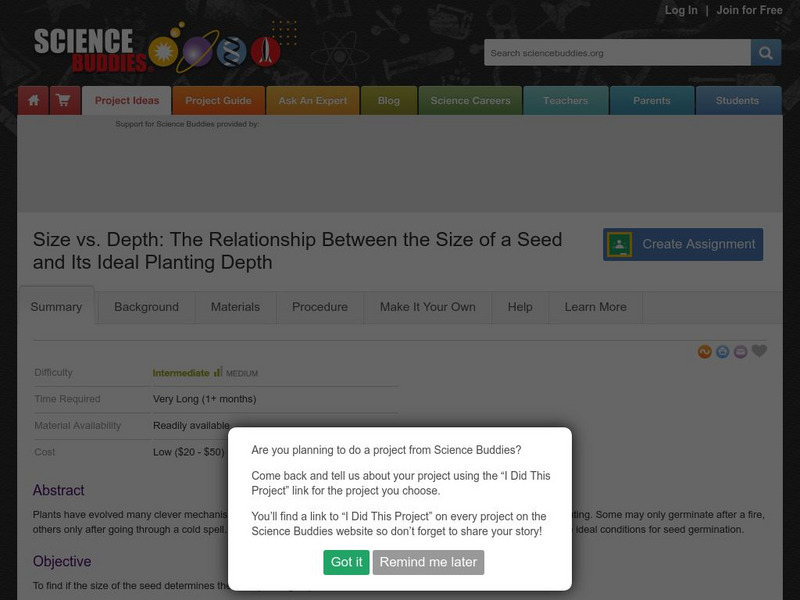Curated OER
Dune Plan Adaptations
Students tour Coal Oil Point Reserve. They locate the species of plants that are on the handouts ,and describe the different adaptations used by plants in their specific area of the dunes.
Curated OER
Finding and Collecting in the Field
Learners examine the types of plants brought over to America from immigrants. They research how some of these types of plants cause damage and alter the landscape. They record data and share the information with the community.
Curated OER
Cotton and Cabbage
High schoolers note how given traits could be achieved by selective breeding and by transgenesis. They identify different uses of GEO. Students recognize that the use of letters (Bt) before an organism's name means that the organism has...
Curated OER
Let it Grow, Let it Grow, Let it Grow
Students investigate, through a hands-on activity, in which type of soil a bean seed grows best. They create a bar graph representing each plant's growth in different soils.
Curated OER
Our Changing Environment-- A Demonstration
Middle schoolers observe and describe changes in an environment when some of the components are changed. They recognize the process of succession by
preparing a miniaturized environment in which a variety of plants and seeds are grown.
Curated OER
Living Corn Necklace
Sixth graders complete an experiment to learn about hereditary traits. In this hereditary traits instructional activity, 6th graders discuss similarities and differences in corn and complete charts for their discussion. Students then use...
Curated OER
The Grass is Always Greener
Third graders experiment with common grass and cellular division.
Curated OER
We All Start Somewhere
Students demonstrate an understanding that the same data can lead to different interpretations and conclusions and that different interpretations and conclusions are not necessarily wrong, but can be useful in developing other scientific...
Curated OER
Land Use Issues
Students discover seeds are a source of life. They also label the parts of a seed and examine the conditions which are needed for the seed to start growing. They follow the life cycle of seeds.
Curated OER
How Does it Affect Plants?
Middle schoolers examine the effects of acid rain on plants. They observe the growth of seeds and the health of different plants for a month. They share their findings with the community.
Curated OER
Birth, Growth, And Development
Young scholars understand that all living things have a life cycle that includes being born, developing into an adult, reproducing, and eventually dying.
Curated OER
Enzymes in Action: An Inquiry Approach to the Effects of Enzymes
Pupils experiment with enzymes as key components of chemical reactions in all living things through this series of lessons.
Curated OER
Air in the Home: Free for All
Young scholars explain that air is everywhere and discuss how living things use air.
Curated OER
Zigzag Seeds
Young scholars observe the effects of gravity on seeds. Students place seeds in various orientations and record their growth to determine how gravity affects the seeds' growth.
Curated OER
Toxicology 2: Finding the Toxic Dose
Students brainstorm with group partners to decide upon a chemical they would like to test, and outline a procedure for their investigation. They then present in groups their ideas to the rest of the class as well as the chemical they...
Curated OER
Sunlight Necklaces
Third graders review the placement and role of the sun in the solar system. Using beads, they create a necklace which they can use to identify the amount of sunlight is being illuminated. In groups, they record observations on the...
Curated OER
Fungi
Pupils study fungi and its parts. In this exploring fungi lesson plan students fill out a worksheet that includes a diagram of fungi and questions.
PBS
Pbs Learning Media: Germinator
This ZOOMSci video segment teaches you how to germinate seeds in a plastic bag and helps you understand some of the factors that influence the germination process. [2:19]
Science Buddies
Science Buddies: Planting Size vs. Depth
Plants have evolved many clever mechanisms to ensure that their seeds will wait for appropriate conditions before sprouting. Some may only germinate after a fire, others only after going through a cold spell. This project explores one...
Science Buddies
Science Buddies: Hydrogen Peroxide on Plant Root Cuttings & Seed Germination
Hydrogen peroxide (often used as a disinfectant) has also been approved for use in pesticides. This science fair project investigates whether hydrogen peroxide has any effects on seed germination or on roots of plant cuttings.
University of Illinois
University of Illinois Extension: The Great Plant Escape Parts of a Seed
Help Detective Le Plant discover how a seed grows into a plant. Students will learn to describe a seed's structure and what's needed for seed growth.
Ohio State University
Ohio State University: Development From Seed to Plant
A thorough discussion of the environmental cues that can trigger germination and of the changes in structure that result. Charts, graphs, and links are also provided.
University of Maryland
Umbc/plant Growth and Development
A good description of the growth and changes in plants from the seed through the adult plant. College level discussion that includes the chemicals involved in the regulation of plant growth.
Science Buddies
Science Buddies: Project Ideas: Rad Radishes: Irradiation on Seed Germination
In this plant biology science fair project, students will investigate effects of irradiation on seed germination. The Science Buddies project ideas are set up consistently beginning with an abstract, objective, and introduction, followed...






















